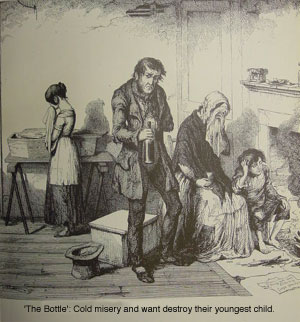![]()
![]()

 The term
'industrial revolution' was used in its technical sense and popularised
by the historian Arnold Toynbee, and is generally used to refer to the
development in industry which began about 1750-60. It was during the reign
of George III that the first phase of industrilisation took place. The
phrase was probably first used by the French economist Auguste Blanqui,
his intention being to show that the economic and social upheavals of England
were comparable
in scope and consequence with the political events during the French Revolution.
The term
'industrial revolution' was used in its technical sense and popularised
by the historian Arnold Toynbee, and is generally used to refer to the
development in industry which began about 1750-60. It was during the reign
of George III that the first phase of industrilisation took place. The
phrase was probably first used by the French economist Auguste Blanqui,
his intention being to show that the economic and social upheavals of England
were comparable
in scope and consequence with the political events during the French Revolution.


 It
is a strange and bitter irony that a period which vastly increased the
wealth of this country should also have intensified the poverty of so many
people. Because labor was plentiful it was cheap, and although prices
rose steeply wages were at starvation level. The general excitement caused
by this new era of industrilisation now found more definite political expression.
A new class was emerging and within it fierce agitation was started to
repeal the unjust laws and reform Parliament.In the
eighty years between 1750 and 1830 the events that happened in England
would affect the lives of people throughout the world. It was one of the
great turning points of human civilisation.
It
is a strange and bitter irony that a period which vastly increased the
wealth of this country should also have intensified the poverty of so many
people. Because labor was plentiful it was cheap, and although prices
rose steeply wages were at starvation level. The general excitement caused
by this new era of industrilisation now found more definite political expression.
A new class was emerging and within it fierce agitation was started to
repeal the unjust laws and reform Parliament.In the
eighty years between 1750 and 1830 the events that happened in England
would affect the lives of people throughout the world. It was one of the
great turning points of human civilisation.

 The first
steam engine was patented in 1698 by Thomas Savery. Savery, a military
engineer, had been working on the problem of pumping water out of coal
mines. His machine consisted of a closed vessel filled with water into
which steam under pressure was introduced. This forced the water upwards
and out of the mine shaft. Thomas Newcomen, an English blacksmith, invented
the atmospheric steam engine which was an improvement on the Savery engine.
A Newcomen steam engine uses the force of atmospheric pressure to do the
work. In 1712 Newcomen together with John Calley built their first engine
on top of a mine shaft and used it to pump water out of the mine.
The first
steam engine was patented in 1698 by Thomas Savery. Savery, a military
engineer, had been working on the problem of pumping water out of coal
mines. His machine consisted of a closed vessel filled with water into
which steam under pressure was introduced. This forced the water upwards
and out of the mine shaft. Thomas Newcomen, an English blacksmith, invented
the atmospheric steam engine which was an improvement on the Savery engine.
A Newcomen steam engine uses the force of atmospheric pressure to do the
work. In 1712 Newcomen together with John Calley built their first engine
on top of a mine shaft and used it to pump water out of the mine.

 In 1765,
James Watt, while working for the University of Glasgow, was giving the
task of repairing a Newcomen engine. Watt made several improvements on
Newcomen's design and in 1769 patented a new engine. Watt's engine became
the dominant design for all steam engines. This new source of steam power
was soon in demand from all mining districts in England and orders came
from France, Russia and Germany. In 1781 the first attempts were made to
use steam power on ships, and in 1801 Trevithick made a clumsy start with
a locomotive. It was some time before the technical difficulties in both
cases could be overcome.
In 1765,
James Watt, while working for the University of Glasgow, was giving the
task of repairing a Newcomen engine. Watt made several improvements on
Newcomen's design and in 1769 patented a new engine. Watt's engine became
the dominant design for all steam engines. This new source of steam power
was soon in demand from all mining districts in England and orders came
from France, Russia and Germany. In 1781 the first attempts were made to
use steam power on ships, and in 1801 Trevithick made a clumsy start with
a locomotive. It was some time before the technical difficulties in both
cases could be overcome.
Steam supplied the reliable source of motive power that was central to the development of mechanical mass production. The historian T.S. Ashton concluded that 'steam was the pivot on which industry swung into the modern age'. However, it did not replace wind, water and animal power overnight, and it was not until the mid-19th century that steam became the main source of industrial power.
 At the
outset of the Railway Age few people would have believed the profound effects
which the railways would have upon the social and economic structure of
the country. The railway network spread over the country at an astonishing
speed : in 1840 there were 1,646 miles of track ; 1851, 6,890 miles ; 1859,
10,000 miles ; by 1900 this figure was more than doubled. Even after the
proven success of the railways, there was no widespread appreciation of
their great destiny, and therefore no attempt to plan a system for the
country as a whole.
At the
outset of the Railway Age few people would have believed the profound effects
which the railways would have upon the social and economic structure of
the country. The railway network spread over the country at an astonishing
speed : in 1840 there were 1,646 miles of track ; 1851, 6,890 miles ; 1859,
10,000 miles ; by 1900 this figure was more than doubled. Even after the
proven success of the railways, there was no widespread appreciation of
their great destiny, and therefore no attempt to plan a system for the
country as a whole.
Railways were undoubtedly the culminating technical triumph of the 'industrial revolution', accelerating the pace of development and immeasurably widening the range of industrial and commercial possibilities. The most important consequences of the railways were as follows :
1. The speed of travel was increased fourfold.
2. Although they had been designed for the carriage of goods, it was not long before the bulk of their revenue was coming from passenger traffic.
3. The mobility of labour was greatly increased and population redistributed; the maintenance of standard wage rates was thus rendered easier.
4. As a result of this enhanced mobility, urban congestion and slums were almost inevitable.
5. Railways stimulated the growth of towns and altered their relative importance; the deviding line between town and country became more tenuous, and country life entered a period of decline.
6. Local specialisation was encouraged by the railways, and domestic trade increased.
7. Industrial growth in the hilly parts of North England, Wales and the central region was held up until the advent of the railway; the rapid growth of Birmingham and the Midlands was due largely to the railways.
8. Industries were encouraged to concentrate along the railways; the distribution and circulation of goods thus became easier and cheaper, and many districts could now draw upon the resources of the whole country instead of being restricted to the immediate neighborhood.
9. Merchants and middlemen did not need to carry such large stocks of goods; hence, they needed less credit to carry on their businesses, and a smaller proportion of the national wealth was locked up in stores and warehouses.
Railways from their inception required new forms of state intervention. They needed Parliamentary approval for the compulsory purchase of land, and the state also became involved over the regulation of safety and of monopolistic practices.